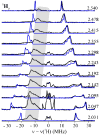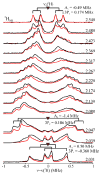Modeling the signatures of hydrides in metalloenzymes: ENDOR analysis of a Di-iron Fe(μ-NH)(μ-H)Fe core
- PMID: 22823933
- PMCID: PMC3433054
- DOI: 10.1021/ja303739g
Modeling the signatures of hydrides in metalloenzymes: ENDOR analysis of a Di-iron Fe(μ-NH)(μ-H)Fe core
Abstract
The application of 35 GHz pulsed EPR and ENDOR spectroscopies has established that the biomimetic model complex L(3)Fe(μ-NH)(μ-H)FeL(3) (L(3) = [PhB(CH(2)PPh(2))(3)](-)) complex, 3, is a novel S = (1)/(2) type-III mixed-valence di-iron II/III species, in which the unpaired electron is shared equally between the two iron centers. (1,2)H and (14,15)N ENDOR measurements of the bridging imide are consistent with an allyl radical molecular orbital model for the two bridging ligands. Both the (μ-H) and the proton of the (μ-NH) of the crystallographically characterized 3 show the proposed signature of a 'bridging' hydride that is essentially equidistant between two 'anchor' metal ions: a rhombic dipolar interaction tensor, T ≈ [T, -T, 0]. The point-dipole model for describing the anisotropic interaction of a bridging H as the sum of the point-dipole couplings to the 'anchor' metal ions reproduces this signature with high accuracy, as well as the axial tensor of a terminal hydride, T ≈ [-T, -T, 2T], thus validating both the model and the signatures. This validation in turn lends strong support to the assignment, based on such a point-dipole analysis, that the molybdenum-iron cofactor of nitrogenase contains two [Fe-H(-)-Fe] bridging-hydride fragments in the catalytic intermediate that has accumulated four reducing equivalents (E(4)). Analysis further reveals a complementary similarity between the isotropic hyperfine couplings for the bridging hydrides in 3 and E(4). This study provides a foundation for spectroscopic study of hydrides in a variety of reducing metalloenzymes in addition to nitrogenase.
Figures










Similar articles
-
ENDOR Characterization of (N2)FeII(μ-H)2FeI(N2)-: A Spectroscopic Model for N2 Binding by the Di-μ-hydrido Nitrogenase Janus Intermediate.Inorg Chem. 2018 Oct 1;57(19):12323-12330. doi: 10.1021/acs.inorgchem.8b02021. Epub 2018 Sep 17. Inorg Chem. 2018. PMID: 30222330 Free PMC article.
-
57Fe ENDOR spectroscopy and 'electron inventory' analysis of the nitrogenase E4 intermediate suggest the metal-ion core of FeMo-cofactor cycles through only one redox couple.J Am Chem Soc. 2011 Nov 2;133(43):17329-40. doi: 10.1021/ja205304t. Epub 2011 Oct 7. J Am Chem Soc. 2011. PMID: 21980917 Free PMC article.
-
ENDOR characterization of a synthetic diiron hydrazido complex as a model for nitrogenase intermediates.J Am Chem Soc. 2008 Jan 16;130(2):546-55. doi: 10.1021/ja073934x. Epub 2007 Dec 20. J Am Chem Soc. 2008. PMID: 18092774
-
High-Resolution ENDOR Spectroscopy Combined with Quantum Chemical Calculations Reveals the Structure of Nitrogenase Janus Intermediate E4(4H).J Am Chem Soc. 2019 Jul 31;141(30):11984-11996. doi: 10.1021/jacs.9b04474. Epub 2019 Jul 16. J Am Chem Soc. 2019. PMID: 31310109 Free PMC article.
-
Insight into the Iron-Molybdenum Cofactor of Nitrogenase from Synthetic Iron Complexes with Sulfur, Carbon, and Hydride Ligands.J Am Chem Soc. 2016 Jun 15;138(23):7200-11. doi: 10.1021/jacs.6b00747. Epub 2016 Jun 3. J Am Chem Soc. 2016. PMID: 27171599 Free PMC article. Review.
Cited by
-
Tuning ligand field strength with pendent Lewis acids: access to high spin iron hydrides.Chem Sci. 2019 May 7;10(21):5539-5545. doi: 10.1039/c9sc00561g. eCollection 2019 Jun 7. Chem Sci. 2019. PMID: 31293738 Free PMC article.
-
Reactivity, Mechanism, and Assembly of the Alternative Nitrogenases.Chem Rev. 2020 Jun 24;120(12):5107-5157. doi: 10.1021/acs.chemrev.9b00704. Epub 2020 Mar 4. Chem Rev. 2020. PMID: 32129988 Free PMC article. Review.
-
Low-Coordinate Iron Hydride Chemistry at an N,N,C-Heteroscorpionate Platform.Inorg Chem. 2024 Aug 5;63(31):14449-14458. doi: 10.1021/acs.inorgchem.4c01596. Epub 2024 Jul 22. Inorg Chem. 2024. PMID: 39037731 Free PMC article.
-
A 10(6)-fold enhancement in N2-binding affinity of an Fe2(μ-H)2 core upon reduction to a mixed-valence Fe(II)Fe(I) state.J Am Chem Soc. 2014 Oct 1;136(39):13853-62. doi: 10.1021/ja507217v. Epub 2014 Sep 18. J Am Chem Soc. 2014. PMID: 25184795 Free PMC article.
-
Interplay between Terminal and Bridging Diiron Hydrides in Neutral and Oxidized States.Organometallics. 2017 Jun 12;36(11):2245-2253. doi: 10.1021/acs.organomet.7b00297. Epub 2017 May 18. Organometallics. 2017. PMID: 28781408 Free PMC article.
References
-
- Igarashi RY, Laryukhin M, Santos PCD, Lee H-I, Dean DR, Seefeldt LC, Hoffman BM. J Am Chem Soc. 2005;127:6231. - PubMed
-
- Fan C, Teixeira M, Moura J, Moura I, Huynh B-H, le Gall J, Peck HD, Jr, Hoffman BM. J Am Chem Soc. 1991;113:20.
-
- Stein M, Lubitz W. Phys Chem Chem Phys. 2001;3:5115.
-
- Lubitz W, Reijerse E, van Gastel M. Chem Rev (Washington, DC, U S) 2007;107:4331. - PubMed
-
- Amara P, Mouesca J-M, Volbeda A, Fontecilla-Camps JC. Inorg Chem (Washington, DC, U S) 2011;50:1868. - PubMed
Publication types
MeSH terms
Substances
Grants and funding
LinkOut - more resources
Full Text Sources
Research Materials

